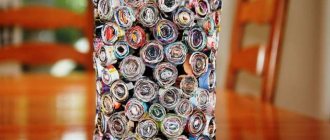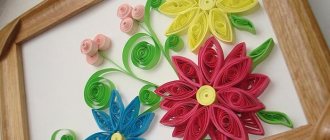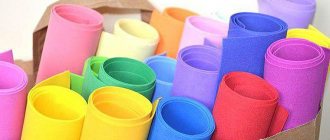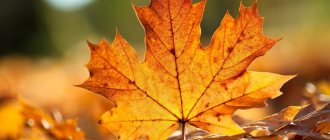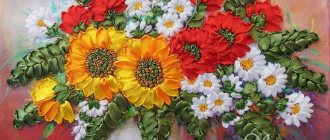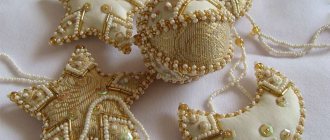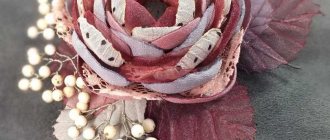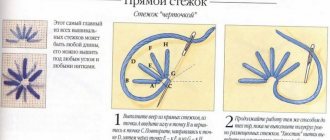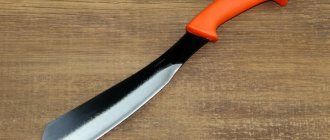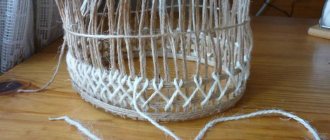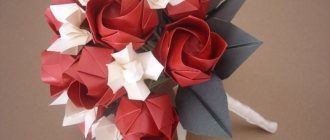Home » Decor
DIY decor
Alyona
151295 Views 1 comment
Quilling
Quilling is a word that few people are familiar with. This means making figures from strips of paper twisted into spirals. Is it really that simple and easy to do? The variety of options will surprise you.
Next, I will tell you how to create beautiful things from ordinary paper. This type of activity will help you brighten up long winter evenings or make a beautiful thing with your own hands and give it to your loved one. Or maybe after my lessons, it will become a hobby for you and will even bring in a small income.
But to understand what it is, to find out who invented it, let's plunge into the history of quilling.
How to make beautiful flowers in quilling style
You should start making quilling fakes for beginners (flowers) only after the idea of such a decor has been thought through. Only after this can you start creating a sketch.
The sequence of steps for making a beautiful paper flower is as follows:
- Selection of a flower, accompanied by a study of its structure and a search for photographs of the original. It is worth carefully counting the number of leaves and petals, as well as finding the size of the stem.
- Preparation of the necessary tools and materials. For a novice craftsman, it is important to buy a special stencil that will help obtain even shapes for the flower.
- Preparing the work area. Care should be taken not to allow any glue to get on the backing or paper strips.
- Preparing the exact number of parts.
Regarding the last point, it is important not to rush and do everything in advance. Quilling should allow the master to enjoy the process, and not irritate a person over trifles.
Simple flowers
Simple, but no less beautiful flowers are made from the basic shapes “drop”, “foot”, “arrow” and many others, which the composition will consist of depends on the desire of the needlewoman.
Simple quilling flower
Materials:
- paper tapes of various colors;
- PVA glue;
- awl or toothpick;
- scissors.
Step-by-step instruction:
- Twist the loose spirals and glue the ends.
- Make a “drop” shape by flattening one side of the spiral with your fingers.
- Roll tightly for the core (you can also use beads).
- Connect all the elements together.
To make the petals large, several basic shapes are glued together. It is recommended to use multi-colored stripes.
Delicate roses
If you twist the ribbon and constantly bend it, you will get a charming rose. Follow the step-by-step photo instructions to create this beauty.
Composition example:
Materials and tools
Quilling fakes for beginners (flowers) involve the use of the following materials and tools:
| Special quilling tool | These devices can be purchased at an office supply store or specialty department. In appearance, the tool resembles a long ballpoint pen with a forked metal tip located at the end. |
| Paper strips | This material can be purchased or made on your own. It is important to remember that the process will require paper of different widths - from 3 to 10 mm. |
| PVA glue | You can buy the simplest option. You don't need a huge amount of glue to work. Therefore, at the initial stage it is worth taking a small tube |
| Ruler-stencil or backing | The tool is a simple ruler with cutouts of various diameters in the shape of circles. The stencil helps novice craftsmen cut out elements of the same size |
| Safety pins with colorful ears | They are used when decorating a large flower arrangement. |
| Cork base for gluing parts | Paper elements will not stick to such a base, and the master does not have to worry about the risks of ruining his work |
| Sharp scissors for cutting fine fringes | |
| Tweezers for compositions with a large number of small parts |
All of the listed quilling components can be purchased immediately in a kit. This will allow the craftsman to save time in searching for missing parts and reduce the cost of a set of quilling items.
Option number 1 for beginners
A bright, colorful product that even those who have recently become acquainted with quilling and are taking their first steps in understanding this art can handle.
To create the product you will need:
- • Paper strips in a variety of colors and lengths. You can use ribbons from various quilling kits or cut them yourself.
In this case, it is worth paying attention to the width and density of the stripes. These indicators must be the same for all blanks so that the vase looks neat and impressive.
- • PVA glue.
- • A quilling tool or any available tool that can be used to replace it.
You also need to prepare a glass, a “pot-bellied” jar, a real vase of any shape and size, or even just a plastic bottle. They will be used as a frame - a base.
simple flower
To work on making an ordinary flower using the quilling technique, the master will need to arm himself with the following materials:
- Double-sided colored stripes 0.5 cm wide.
- Special device for twisting.
- PVA.
- Cardboard, pencil, sharp scissors.
Quilling fakes for beginners (flowers) are made in the following sequence:
- A colored square paper sheet with approximate parameters of 10x10 cm is prepared.
- A spiral appears in the middle of the sheet.
- Using sharp scissors, the design is cut out along the drawn lines.
- The cut spiral is twisted using a special device or an awl.
Using this technique, the master will be able to make a simple rose. Next, you can make 4 more flowers and create a beautiful composition.
Scope of application of quilling technique
There are many options for using the quilling technique. This list includes:
- floral appliques on a flat base;
- outline images;
- looped compositions;
- individual flowers and bouquets;
- three-dimensional paintings and crafts.
Floral appliques on a flat base
Appliques on a flat base are the simplest products using the quilling technique. It’s worth starting to study this type of needlework with them. Such crafts are made from paper rolls glued in one row, that is, the individual elements do not lie on top of each other, but are located on the same level.
Outline images
This technique is also called silhouette or graphic quilling. It consists of creating images with paper strips that are not crowded into rolls and loops. The elements are given the desired shape by making waves, bends and angles.
Looped compositions
Elements of a product created using this technique consist of loops of different sizes. They are woven using a wide-toothed comb or pins placed at the required distance from each other.
Individual flowers and bouquets
At the first stage of working with the quilling technique, it is better not to immediately take on a voluminous complex composition, but to try to make individual flowers without attaching them to the base. Such small crafts can serve not only as preparation for more serious products, but also become an excellent souvenir. Volumetric bouquets can be made from flowers, connecting them with wire (regular or floral).
Three-dimensional paintings and crafts
Such compositions are created by attaching flowers and leaves to a base in several levels.
Volumetric flower
For a voluminous flower you will need:
- 22 strips of paper at least 65 cm long.
- Special tool.
- PVA.
- Sharp scissors.
- Colored paper.
First of all, the master chooses the color of the future flower. You can even make a two-color composition. In this case, paper strips should be used in several colors (11 pieces of each color).
The work process itself looks like this:
- Paper strips prepared in advance are rolled with a special tool into tight rolls.
- Each roll fluffs up to a diameter of 2 cm.
- Circles are cut from colored paper (if quilling skills are not yet sufficient, you can use a stencil).
- A rhombus is made from round parts. To do this, the element is flattened on both sides and then stretched.
The combination of the resulting parts will allow the master to create a large number of beautiful three-dimensional flowers.
What is made from quilling?
You can twist anything from paper strips: from simple toys for kids to complex artistic panels. So what can you do with quilling?
- Designer inscriptions and drawings on cards, invitations, wall panels
- Decor for scrapbooking
- Seasonal and holiday decorations
- Earrings, necklaces, bracelets and other jewelry
- Fun toys and souvenirs
- Interior items: organizers, candlesticks, stands, caskets, photo frames, storage boxes, vases and various little things that help organize space and are pleasing to the eye
Quilling is good because it is accessible not only to adults, but also to children. This type of needlework can captivate the whole family. You will spend a lot of time creating interesting, beautiful crafts and compositions.
Carnations
A quilling fake for beginners, such as carnation flowers, can be made armed with the following tools:
- Wide red stripe.
- Green paper.
- Cutting tool.
- Toothpicks.
- Glue.
The work sequence looks like this:
- Cuts are made on the red strip in a vertical direction.
- The toothpick is wrapped in green paper and secured with PVA.
- The beginning of the red strip is glued to the finished stem. Next, you need to screw it on and secure the end with glue.
The last step will be straightening the finished flower.
Vase based on basic quilling elements
This MK is perfect for beginning needleworkers, since this vase can be made from the simplest quilling element - a thick roll.
To work you will need:
It is better to take strips for such a vase that are quite dense. Ready-made kits are perfect. But if you prepare the materials yourself, keep in mind that strips of very thin paper will produce rounds with a smaller diameter than those made of thick paper.
Instructions on how to make a multi-colored vase in the quilling style: first, make a bottom-base on which the vase will stand. Quilling strips for parts are wound very tightly onto a toothpick. When the first strip ends, the second is glued to it, and thus continue to wind the multi-colored strips until you get the bottom of the desired diameter.
The remaining parts are made according to the same principle. It is advisable to make as many of them as possible. To make it more convenient to make parts of the same size, you can use a ruler with circle stencils. But in the case of round pieces of different diameters, the vase will look even more original.
Now we glue the resulting parts along the edge of the bottom. Try not to get glue on the mold, so that later it will not be a problem to remove the product from it. The remaining parts are glued together at the edges.
When the glue dries, the craft can be removed from the base. Such a bright vase will decorate the interior, even if you don’t put anything in it.
Video: Making a flower vase
Dandelions
To get started, you should prepare:
- Dense yellow stripes.
- Green stripes (used for leaves).
- Crumpled paper from which the bud and stem are made.
- Sharp scissors.
- Tweezers.
- PVA.
To make a dandelion, the width of any piece is taken at the rate of 3.5 cm. 1 flower will take several strips, the length of which will be equal to a landscape-size sheet.
The manufacturing process itself is carried out in the following sequence:
- 3 strips are prepared for subsequent cutting of petals. Each workpiece is folded in the middle, and petals are cut, the size of which is 0.5 mm.
- Using a special tool, one yellow strip is twisted, and its tip is secured with PVA. Next, orange ones are screwed onto the yellow strip, pre-glued into one long strip.
- The petals gently unbend.
- A green paper rectangle is prepared for the leaves. This part is folded in the middle and a sheet is cut out.
- The resulting fragment is compressed into an accordion to give it realism.
- Bud. For it you need to prepare 1/3 of the strips and cut the petals. Then roll the roll from the strip and secure it with PVA.
All that remains is to cut a strip 2cm wide from the header. The edges of the part are glued, the bud is placed and wrapped in paper. The remaining part of the stem is curled.
Assembly sequence
We will use paper tapes of different sizes:
- • glued from 3 standard strips;
- • of 3.5 stripes;
In this case, the width of all stripes should be the same - 4 mm.
First step . Let's make the base. It consists of 1 tight roll, 8 “eyes” and 16 drops. All elements, with the exception of the central spiral, are twisted from ribbons consisting of 3.5 strips. To make the middle, we roll up two standard strips glued in series.
After the base has dried, we attach 8 “drops” (out of 3.5 90 , turning them wide side down.
The second row consists of exactly the same elements. We glue them between the “bricks” of the previous row with the pointed end down. When assembling, we slightly deflect these elements from a right angle back (towards the outside of the vase).
For the third row of ribbons glued together from 3 strips, we form 8 “eyes” and the same number of rings. We glue the first ones between the drops of the previous row, and the second ones we place between the “eyes”.
To make rings, simply wrap the paper several times around a regular ballpoint pen and secure the tip with glue.
The fourth row consists of “drops” ( 3.5 stripes), glued together in pairs. 16 elements are required 8 double blanks. We attach these hearts to the previous row as shown in the figure.
For the fifth row, we glue together two “eyes” and one drop (out of 3.5 strips). And then we add tight spirals between them. Twisted from the same number of quilling strips.
The next row ( 6 ) is made from “checkmarks” assembled from “eyes” of size 3.5 . In total you will need 16 such blanks.
For the final row we form the same details as for the 5th row and the ring. For all elements we use rolls of 3.5 stripes.
The end result is a vase like this. We secure the entire product again with glue for reliability. And after it dries, remove it from the backing.
Roses
Quilling fakes for beginners (rose flowers) will require the master to have standard tools and material:
- paper;
- stencil;
- PVA;
- wax paper;
- safety pins. Rose Flower is a simple quilling craft for beginners
The manufacturing sequence includes the following steps:
- First of all, a teardrop-shaped bud of the future flower is made from a pre-prepared blank.
- For the flower itself, it is worth gluing 5 petals.
- The second layer involves an identical flower, but with smaller petals. You can get them by slightly twisting the paper.
- For the flower stems, you should take green and yellow strips and roll them into an accordion shape.
- The stems are glued to the composite base.
All that remains is to collect all the details into the composition.
Asters
To work, the master should prepare:
- colored paper (double-sided);
- sharp scissors;
- 20 rhinestones;
- a special quilling tool for twisting paper strips;
- PVA.
Astra is made using quilling technology as follows:
- A paper strip is cut out with a length of 30 cm and a width of 3 cm. The part is folded in half lengthwise.
- Using sharp scissors, several small cuts are made on the workpiece.
- Using a tool or an awl, the strip is twisted.
- On the finished roll, the fringe should be unscrewed from the outside.
To make flowers of different sizes, you should vary the parameters of the paper strips.
Execution Sequence
Having glued several strips of different colors together, we roll up a fairly large and very dense roll.
Its diameter must correspond to the bottom of the vessel, which is used as a frame. We place the finished spiral on the base turned upside down, but do not glue it.
We prepare as many rolls as possible. To curl them, you can use a variety of combinations of paper strips. The diameter of the elements can be different, or they can all be adjusted to a single size using a template.
We glue the spirals in a circle to the paper bottom ( but not to the vessel that acts as a frame! ) Additionally, the disks can be glued together.
Having glued the first row using the same principle, we continue to attach the subsequent ones.
We continue working until multi-colored spirals cover the entire frame.
After this, let the product dry thoroughly (at least 15 minutes), turn it over and remove the frame from the inside.
This vase of flowers will fit into any interior. By the way, you can buy flowers ready-made, or you can make them yourself, which will only add exclusivity to the decoration.
Daisies
To work you will need:
- White stripes with a width of 2 mm.
- Light green and yellow stripes with a width of 7 mm.
- PVA.
- Sharp cutting tool.
- Special device for twisting.
The flower is made in several stages.
Petals
To make the petals, you should use white paper strips.
The process then looks like this:
- One piece is taken and several windings are made with the tool. The device is removed, and a strip with a twisted end remains.
- The part is brought to the state of the finished roll.
- The element unwinds carefully. It is important to hold the part with two fingers of your right hand. Next, with your left hand, the middle is stretched to the sides. At the opposite edge the spiral contracts. Such manipulations are performed along the entire length.
- PVA is applied to the end of the strip and the part is glued. The size of the resulting droplet cannot exceed 1.5-1.7 cm.
The number of petals depends on the volume of the finished flower. Often at least 15 petals are required per flower.
Flower core
When making a chamomile core, the master must adhere to the following sequence of actions:
- Light green and yellow stripes are prepared. They are cut into fringes. The thinner the cutting becomes, the more beautiful the flower will turn out. To avoid a through cut, it is worth attaching a cardboard stopper.
- Each finished element is cut into 2 identical halves.
- Next, you should glue the strips of different colors together. To do this, make an indent of about 1 cm on the yellow piece and apply PVA (you can use a toothpick). A light green stripe is glued on top.
- The resulting two-color pair is twisted several turns using a quilling tool.
- Then the strip is rolled by hand until it forms a tight roll. It is important to twist tightly, otherwise during bending the part will become unusable for subsequent use.
- At the very end of the twist, you need to trim the end of the light green strip, making its length shorter than the yellow one.
- PVA is applied to the cut edges and fixed.
- The roll is bent outward and coated with glue.
All you have to do is wait for the parts to dry (you can tell by the appearance of a transparent layer resembling a glass film) and bend back the fringe at the edges. If you don't wait enough time to dry, the part will flatten.
Chamomile assembly
This process involves a certain sequence of actions. It looks like this:
- A small amount of glue is applied from the sharp end of the petal and the element is fixed to the core of the chamomile.
- Each subsequent petal is glued in an identical way. It is worth remembering that to add individuality, you can place the petals at an angle, or one higher than the other.
The main thing is to achieve a result that will please the master himself. And it is important not to forget that after the glue dries, glue threads may remain in the core. They spoil the appearance of chamomile. Therefore, they should be removed.
A little history
This art form was invented by monks in Europe during the Middle Ages. When they trimmed the edges of gilded books and twisted them around the ends of birds' feathers. Thus, it turned out something similar to a golden miniature.
This is where the name quilling comes from. From the English word “quill”, which translates as “bird feather”. At the very beginning, this was done in poor churches, especially in the 19th century, quilling was a favorite pastime of noble ladies.
In the twentieth century they forgot about him. And at the end of the last century, quilling began to return to people's homes as a hobby.
As a result of his wandering around the world, their own schools began to be formed in each country. And each nation brought something of its own to this type of art. For example, eastern schools differ from European ones in the complexity of patterns, which allows eastern people to create masterpieces of art.
And the Korean school differs from the European one in that when winding the paper, a rod is not used, and everything is done by hand. The works of the Korean school are very complex. In our country this art became popular at the end of the twentieth century.
Therefore, few of us know this type of art thoroughly. I will introduce you to the basics of this art form, give advice, give examples and try to give you all my knowledge. Let's start with the basics.
But before you start doing this type of creativity, you need to prepare. That is, purchase the necessary tools for the job.
Tulips
To make tulips using the quilling technique you will need:
- A flat wooden stick or a special fork (you can use a manicure stick instead of a fork).
- White sheet of paper and gray cardboard.
- Green and pink paper for stripes.
- Zigzag scissors.
- PVA.
The process of making a tulip follows the following sequence:
- The end of one pink strip is wound around a stick until a ring shape appears.
- An indentation is made from the folded edge. The element is bent in half.
- Next, you should twist the bend in the opposite direction from the bent tip. The master should end up with a figure similar to the letter “S”.
- The strip is twisted further at the fold in both directions. So you should make several figures and set them aside.
- Next, take 3 more pink strips and turn them into droplets by gluing the ends together.
- On a white sheet used as a base, the edges are trimmed with scissors. Drops are fixed in the middle of the paper with glue, and S-shaped curls are attached to them.
- 2 drops are glued together, and the third is fixed on them.
- The remaining petal is filled with an S-shaped element. The flower head is ready.
- A light green stripe is attached to the tulip head, symbolizing the stem.
- Several green stripes stick together and become curls. Depending on the artist’s imagination, the curls can be shaped into rings, pointed at both ends, and glued to one another. The finished tulip leaf is glued to the stem.
- Another 3-4 strips turn into S-shaped blanks placed inside the sheet.
To create a complete picture of the flower, it is worth making more leaves in an identical way.
Lilies
To make a lily, a craftsman should arm himself with:
- a set of stripes of pink, white, yellow and black;
- diagram or sketch;
- PVA;
- a special tool for twisting strips;
- a tube of acrylic glossy varnish;
- wires;
- rings with a diameter of 0.7 cm for connection;
- a base for rings that can be expanded to any diameter;
- transparent glue.
The list of actions looks like this:
- First of all, you should make earrings and a pendant.
- Next, you should take pink strips with a width of 3 mm, a length of 95 mm and glue them to white strips with an identical width size, but the length will be 100 mm longer. The edges are glued together. In total, you will need to make 18 stripes for the flower.
- Paper ribbons are wound onto a special quilling tool or toothpick until spirals are obtained. You should start with pink so that these ribbons end up in the middle of the flower.
- The rolls are stretched to form an oval shape and bent at the tips on each side.
- Then a flower is formed by gluing 6 petals.
- To form the core of the lily, you need to take black and yellow strips, 0.15 cm wide and 40 mm long, and twist them into tight spirals (6 pieces yellow and 3 pieces black).
- 1 dark and 2 light spirals are glued together to form the middle of the flower. It should be glued to the center of the future lily.
Using the steps listed above, you can make a flower for a ring. The difference will be the size of the stripes. So, pink ones will be only 40 mm, and white ones will be 95 mm. For the middle, it is necessary to use smaller spirals (the length of the black and yellow stripes will be reduced to 30 mm).
To make jewelry with flowers, all the resulting lilies are coated on both sides with acrylic varnish, and the flower is set aside until completely dry. A smaller flower is fixed to the ring base with polymer glue.
When making earrings, you need to take earrings and, using a connecting ring, attach 2 large flowers to them.
Let's start simple
In most cases, all crafts for making quilling flowers can be divided into 3 large categories:
- Openwork flowers or flowers with fringe
In this article we will consider a master class on quilling colors in accordance with each category.
Standard option
Ordinary flowers created using the quilling technique can be made using classic shapes - quilling details - roll, drop, eye and others.
Basic quilling patterns are given below:
Tools for quilling are special skewers or rods, which can be replaced with toothpicks or thin sticks, glue, colored paper and cardboard. It is better to use double-sided paper for crafts so that there are no differences in color in the curled elements.
So, how to make flowers using the quilling technique for beginners?
- We cut the paper into thin long strips 5 mm wide, or you can use ready-made, store-bought materials.
We begin to roll the strip of paper into a tight roll.
- We loosen the detail a little.
- We squeeze one side of the roll so that we get a droplet and seal the end of the strip.
- In the same way we make blanks for the flower and glue them together.
- You can place a tight, unrolled roll in the middle, or you can place a second layer of petals on the flower itself, but of a smaller size.
- We form stems and long decorative elements from the strips; you can fix them with needles and glue them together.
- The leaves can be formed using the method described above, or you can twist them only at the tips - this will be easier.
- We assemble and glue the entire composition, let it dry.
The result was a very simple, but at the same time beautiful flower, which, undoubtedly, even a child could make. By gluing this composition onto a sheet of paper or cardboard, you can decorate the craft as home decor. It is convenient to prepare such paintings for an already established interior, selecting the colors and sizes of the details.
Volumetric flowers
There are several ways to make three-dimensional flowers.
The simplest one is to create roses as in the photo.
In this case, the paper blank from which the rose will be twisted is not a long strip, but a spiral one.
We cut it out from a square on which we outline a drawing with a pencil.
Next, we twist the part into the shape of a flower and glue the end so that the flower does not bloom.
Creating other three-dimensional flowers will require more attention and skill. The basis for such compositions will be a cone-shaped substrate onto which we will glue the finished petals.
- Let's prepare the base - cut out a circle from thick cardboard, cut it to the center and glue the edges together to form a cone.
- Volumetric flowers will resemble an orchid; to create such a flower, you will need to prepare the following quilling forms - “eye” and “crescent”.
We roll according to the same principle as standard flowers, only we compress the untwisted roll until we get the shape we need.
- Each flower consists of two such structures.
- To create a larger petal, you will need to add several additional “crescents”.
And also for further work you will need a part - a “wave”.
- We will make the core of the flower to match a real orchid. Let's twist the cone and tint it a little using a sponge with paint.
- This is what the whole set will look like.
- Let's start assembling the flower - glue the largest petal onto the cone, two smaller petals on top, and then the petals in the form of a wave and finally the core.
With fringe
Small fluffy flowers look great as an addition to a floral picture. Additionally, this technique can be used to create cores.
Pictures with photos on making flowers with fringe show in detail the entire process of creation.
- Let's prepare paper strips of different colors, 5 and 10 mm wide, about 25 cm long.
- We cut the fringe - it should be 2/3 of the width of the strip. The thinner it is, the fluffier the flower will turn out.
- Glue together a narrow and wide strip with fringe.
- We twist the strips, starting with the narrow one.
- We also continue to twist the fringed strip and glue the end.
And this is what happened:
These flowers can be made in different shades, similar to dandelions, daisies or cornflowers.
Daffodils
When making a daffodil using the quilling technique, it is important to have the following tools and materials:
- Strips of paper 3 and 7 mm wide and 20 cm long.
- Wire for working with the stem.
- Glue gun and sticks for it.
It is worth remembering that stripes will be required for both the flower and the leaves. Therefore, green must be present in the color palette of stripes.
The sequence of actions is as follows:
- For the petals of the future flower, you need to twist the roll using a narrow strip. When unrolled, the diameter of the roll will be 1.2 cm. For accurate measurements, you can use a special stencil with cut holes. The edge of the tape is fixed with glue.
- Next, you should pinch the roll with your fingers. To make one petal, the craftsman should make 3 similar parts. All of them will be connected to each other using a glue gun. One daffodil needs at least 6 petals. It is worth joining the petals into a finished daffodil so that there is a small hole in the center.
- Using yellow stripes, a cup with a diameter of no more than 1 cm is made, and the inside is filled with glue.
- A fringe is made along the edges of the wide ribbon and wound around the cups. The tape must be fixed with glue.
- The finished flower core is inserted into the center and secured. A green strip is wound onto a wire coated with glue.
- Another cup is made from green ribbons and glued to the stem. The base of the daffodil will be glued to this part.
- The leaves are formed using a comb, and they are secured to the base using a glue gun.
It will take a master no more than 1 hour to make a real bouquet of daffodils using this technology.
Making quilling fakes for beginners, especially bright, beautiful and delicate colors, will bring pleasure and will help you turn ordinary paper into a real miracle from the world of art.
Article design: Vladimir the Great
Schemes for creating individual elements
The essence of quilling is to create applications from blanks of different shapes. These elements are first rolled out of paper strips and take on the desired shape. By following the link, you can watch a video that explains step by step the methods for creating all the basic figures - the main elements in quilling.
Master class on quilling technology
Most figures in quilling are created from a loose roll by bending and squeezing. Therefore, having learned how to make this simple workpiece, you can cope with most of the elements that are found in master classes on the described technique.
Tight roll:
- Attach the paper strip to the working tool. If you don’t have a special device, attach the paper to an awl or toothpick.
- Wrap the material several times until it is tightly secured. It is necessary to rotate the tool around its axis so that the entire strip turns into a roll.
- The end is fixed with glue.
Such a detail can become the core of a flower.
Free roll:
- The loose spiral is made in the same way as the previous one, but before fixing the end of the strip, the part is placed in a stencil with a round hole.
- Carefully remove the spiral and secure the end of the strip with glue.
A drop:
- Make a loose roll first.
- On one side, squeeze the strip between two fingers.
Such blanks most often become petals and leaves.
Eye:
To make a part in the shape of an eye, you need to pinch the loose roll on both sides symmetrically. Leaves of this shape are often found in flower arrangements.
Twig:
- Twist 2 spirals, leaving the end straight and not fixing.
- The blanks are glued together at different levels so that the curls point in the same direction.
How to combine colors
To make a flower arrangement using the quilling technique harmonious, you need to pay attention to the combination of colors.
Related Posts
Patterns for crocheting square napkins
There are several rules that can help with this:
- Divide shades into cold and warm, do not mix them.
- Do not use more than 4 colors in a composition that are radically different from each other.
- When choosing colors, use a color wheel (you can find it on the Internet or in a craft store).
- Use monochrome (one-color) combinations.
How to combine shades of the same color
Combinations of shades of the same color always look harmonious and understandable. When choosing this method of forming a picture, you need to use colors that differ in saturation and brightness. This composition always creates visual interest and a sense of unity.
For example, taking a deep emerald color as a basis, it can be diluted with lighter and cheerful shades of green (lime, light green, pistachio). And when working with yellow, you can combine mustard with lemon, complementing the palette with intermediate shades.
